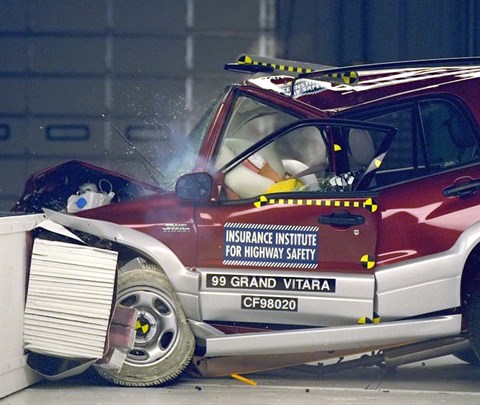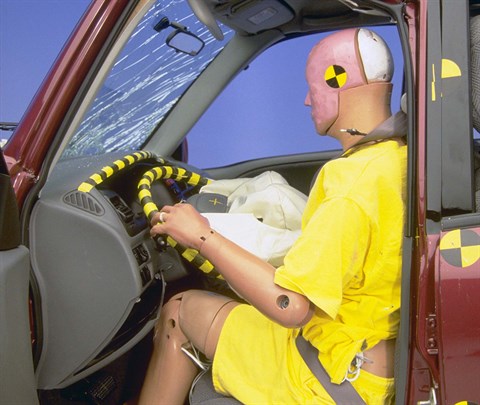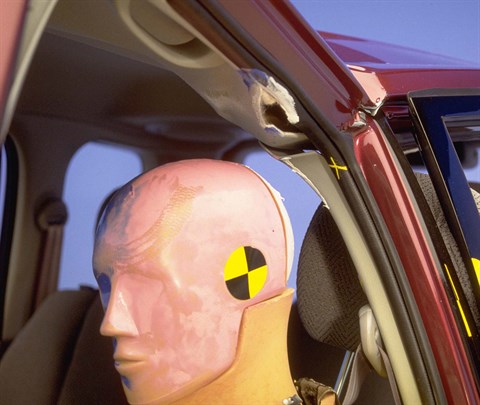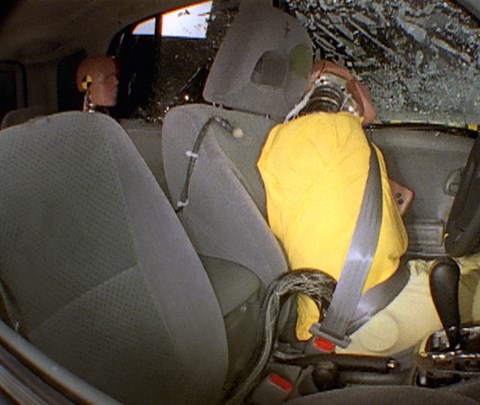Moderate overlap front: original test
Rating applies to 1999-2005 models
Tested vehicle: 1999 Suzuki Grand Vitara JLX 4-door
The Suzuki Grand Vitara and Suzuki Vitara were introduced in the 1999 model year, and the Chevrolet Tracker was redesigned the same year.
| Evaluation criteria | Rating |
|---|---|
| Overall evaluation | |
| Structure and safety cage | |
| Driver injury measures | |
| Head/neck | |
| Chest | |
| Leg/foot, left | |
| Leg/foot, right | |
| Driver restraints and dummy kinematics Dummy movement was reasonably well controlled. The driver door bowed outward and, during rebound from the airbag, the dummy moved up and toward the driver door, hitting the roof rail in front of the B-pillar. | |

Action shot taken during the frontal offset crash test.

The dummy's position in relation to the steering wheel and instrument panel after the crash test indicates that the driver space was maintained reasonably well.

Blue and white paint above the dummy's head indicates where it hit the roof rail, which had bent sharply as the A-pillar moved rearward.

Footwell intrusion and instrument panel movement were minimal.
Side: original test
Rating applies to 1999-2005 models
Tested vehicle: 2003 Suzuki Grand Vitara 4-door 4wd without side airbags (not available)
The Suzuki Grand Vitara and Suzuki Vitara were introduced in the 1999 model year, and the Chevrolet Tracker was redesigned the same year.
| Evaluation criteria | Rating |
|---|---|
| Overall evaluation | |
| Structure and safety cage | |
| Driver injury measures | |
| Head/neck | |
| Torso | |
| Pelvis/leg | |
| Driver head protection The dummy's head was hit by the intruding barrier, producing high head injury measures. | |
| Rear passenger injury measures | |
| Head/neck | |
| Torso | |
| Pelvis/leg | |
| Rear passenger head protection The dummy's head was hit by the pillar behind the rear passenger door. This pillar is required by federal standard to provide some protection for occupants' heads. | |

View of the vehicle and barrier just after the crash test.

View of the vehicle after the crash with doors removed, showing damage to the occupant compartment.

Action shot taken during the side impact crash test showing the driver dummy's head being hit by the intruding barrier.

Smeared greasepaint shows where the driver dummy's head hit the barrier.
Head restraints & seats
Seat type: All seats
| Overall evaluation | |
|---|---|
| Dynamic rating | |
| Seat/head restraint geometry |
About the head restraint & seat test
Currently, IIHS tests apply only to front seats.
